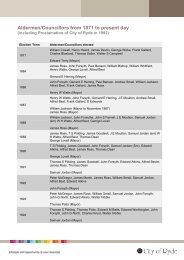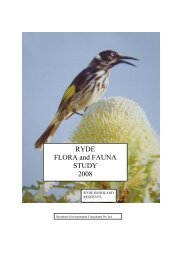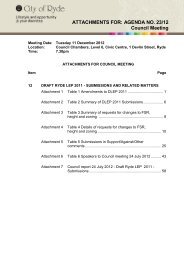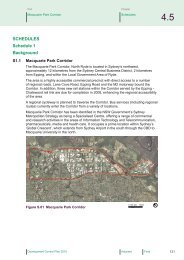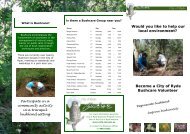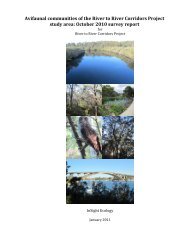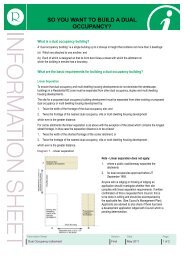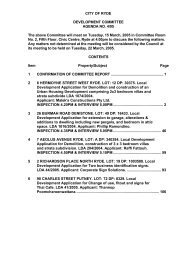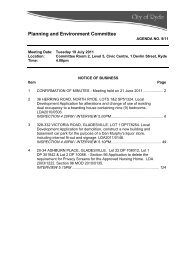RYDE FLORA and FAUNA STUDY 2007 - City of Ryde - NSW ...
RYDE FLORA and FAUNA STUDY 2007 - City of Ryde - NSW ...
RYDE FLORA and FAUNA STUDY 2007 - City of Ryde - NSW ...
Create successful ePaper yourself
Turn your PDF publications into a flip-book with our unique Google optimized e-Paper software.
The only large reptiles still remaining in the <strong>2007</strong> study area are:<br />
Biosphere Environmental Consultants Pty Ltd<br />
<strong>Ryde</strong> Flora <strong>and</strong> Fauna Survey <strong>2007</strong> 5<br />
* Red-bellied Black Snakes (Pembroke Park, Lucknown Park)<br />
* Eastern Water Dragons (many reserves along the Terrys Creek <strong>and</strong><br />
Buffalo Creek catchments)<br />
Frogs have suffered a precipitous decline in <strong>Ryde</strong>. Most reserves have just one or two<br />
species. There appears to be several reasons for the decline <strong>of</strong> frogs:<br />
* loss <strong>of</strong> ephemeral or still-water flooded sites<br />
* extended drought over some years<br />
* loss <strong>of</strong> creek catchment habitat<br />
* poor water quality<br />
* introduced predatory fish (notable the Plague Minnow, Gambusia<br />
holbrooki).<br />
Pond-breeding species are now confined to back-yard habitats <strong>and</strong> have been lost<br />
from creek areas. Most tree frogs have disappeared despite the amount <strong>of</strong> woodl<strong>and</strong><br />
<strong>and</strong> forest that has been retained. This is a direct consequence <strong>of</strong> the loss <strong>of</strong> breeding<br />
habitat.<br />
Most other animal groups have shown declines in diversity.<br />
The fauna groups that are still well represented in the area are forest <strong>and</strong> woodl<strong>and</strong><br />
birds. In many bushl<strong>and</strong> reserves the tall canopy has been retained <strong>and</strong> reserves are<br />
close together so that birds can move freely between bushl<strong>and</strong> areas. The birds that<br />
have declined markedly are the small passerines that require mid-canopy cover for<br />
protection, <strong>and</strong> wading birds. Terrys Creek bushl<strong>and</strong> reserves appear to act as an<br />
important stop-over area for migrating birds as many migratory species were detected<br />
in the reserves.<br />
Invertebrates were well represented in most reserves where there was still a<br />
reasonably intact shrub or ground cover present. Native fish were genereally absent<br />
for the reserves.<br />
1.2.3. Impacts<br />
The types <strong>of</strong> impacts on the bushl<strong>and</strong> areas varied but included:<br />
* weed invasion<br />
* dumping <strong>of</strong> garden wastes <strong>and</strong> household rubbish<br />
* planting <strong>of</strong> non-native or non-endemic plants<br />
* uncontrolled fires that alter plant communities<br />
* contamination <strong>of</strong> creeks <strong>and</strong> ground water<br />
* changes in flow patterns <strong>of</strong> creeks through storm water control<br />
* increased erosion <strong>of</strong> creek banks<br />
* loss <strong>of</strong> ephemeral freshwater habitat<br />
* ground compaction through foot traffic




